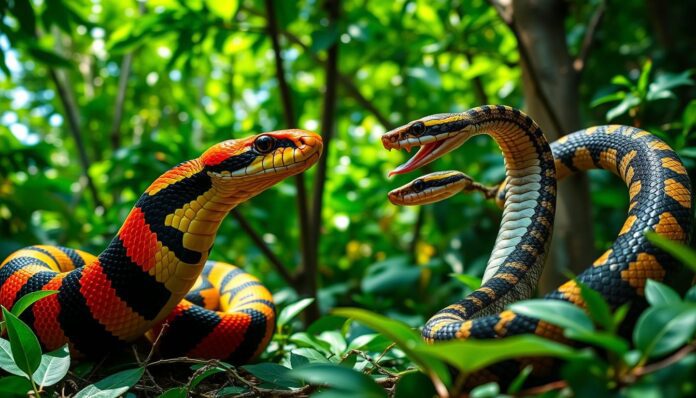The venom of coral snakes is very potent, affecting the nervous system. It can cause paralysis and even death. King snakes, on the other hand, do not have venom. They are safe for humans if they bite.
This difference highlights the unique roles of these two snake species in their ecosystems. It’s a key part of this detailed comparison.
Coral snakes are usually 18 to 20 inches long. They live in forests in Asia and the Americas. There are about 65 species in the Americas and 16 in Asia.
King snakes can grow up to 72 inches long. They live in North America, in many different places like forests and deserts. Both species are important for keeping their ecosystems balanced.
Understanding Snake Mimicry in Nature
Snake mimicry is when non-venomous snakes, like king snakes, look like venomous ones, like coral snakes. This trick helps them stay safe from predators. Coral and king snakes show a perfect example of Batesian mimicry, where safe species look like dangerous ones.
Evolution of Mimicry Patterns
Biologists have found that safe species near dangerous ones often look like them. This helps them survive. The danger of the toxic species affects how well the mimic looks, changing in different places.
Survival Advantages of Similar Appearances
The king snake’s look-alike trick helps it avoid being eaten. Scarlet kingsnakes, for example, have colors that make them hard to spot. They live where coral snakes are found, showing their colors help in more ways than just looking like them.
Role in Ecosystem Balance
Snake mimicry helps keep ecosystems in balance. The presence of king snakes, which look like coral snakes, changes how predators and prey interact. How well they mimic coral snakes can differ depending on where they live.
Coral Snake vs King Snake: Essential Differences
Coral snakes and king snakes look similar but are very different. They have unique venom, hunting ways, and looks. Knowing these differences is key for identifying snakes and staying safe where they live.
Venom and Hunting Techniques: Coral snakes have venom that harms the nervous system. King snakes, on the other hand, are not venomous. They use their strong coils to catch their prey. Coral snakes have small, fixed fangs, while king snakes have rows of small teeth.
Size and Appearance: King snakes are bigger, growing up to 72 inches long. Coral snakes usually reach 18 to 20 inches. King snakes also have more color patterns than coral snakes, which always have a red-yellow-black banding.
Behavior and Habitat: Coral snakes like to hide in sandy, well-drained areas like pine forests. King snakes can live in many places, including deserts and forests. King snakes are not harmed by other snakes’ venom and often eat them.
| Characteristics | Coral Snake | King Snake |
|---|---|---|
| Venom | Venomous with neurotoxic venom | Non-venomous |
| Hunting Method | Small, fixed fangs | Constrictor with rows of small teeth |
| Size | 18 to 20 inches in length | 24 to 72 inches in length |
| Color Pattern | Universal red-yellow-black banding | Diverse range of color patterns |
| Habitat | Reclusive, prefer well-drained, sandy soils | Adaptable to various habitats, including deserts and forests |
| Prey | Lizards, frogs, other reptiles, and smaller snakes | Immune to the venom of other snakes, including coral snakes, and often prey on them |
Knowing the key differences between coral snakes and king snakes helps us identify them safely. This knowledge ensures we can live peacefully with these reptiles in our shared spaces.
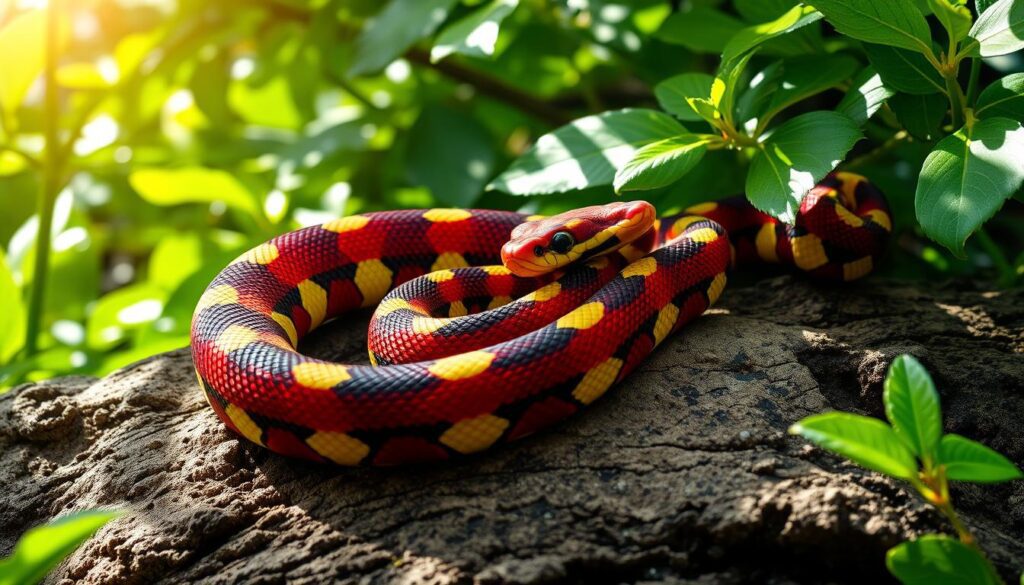
The Famous Color Pattern Rule
Identifying coral snakes and their non-venomous friends is easier with a simple rhyme. “Red touch yellow, kill a fellow; red touch black, venom lack” helps us remember. Coral snakes with red and yellow bands are dangerous, while red and black king snakes are safe.
Red Touch Yellow: The Warning Sign
The coral snake’s red and yellow bands are a warning. This pattern is unique in North America. Its venom is very dangerous and can cause serious harm.
Red Touch Black: The Safe Track
King snakes, which look like coral snakes, have red and black bands. This pattern means they are safe and not harmful to humans.
Regional Pattern Variations
While the color rule works well in the U.S., there are exceptions. Some coral snakes and king snakes have different patterns. It’s important to look at other signs like body shape and behavior to tell them apart.
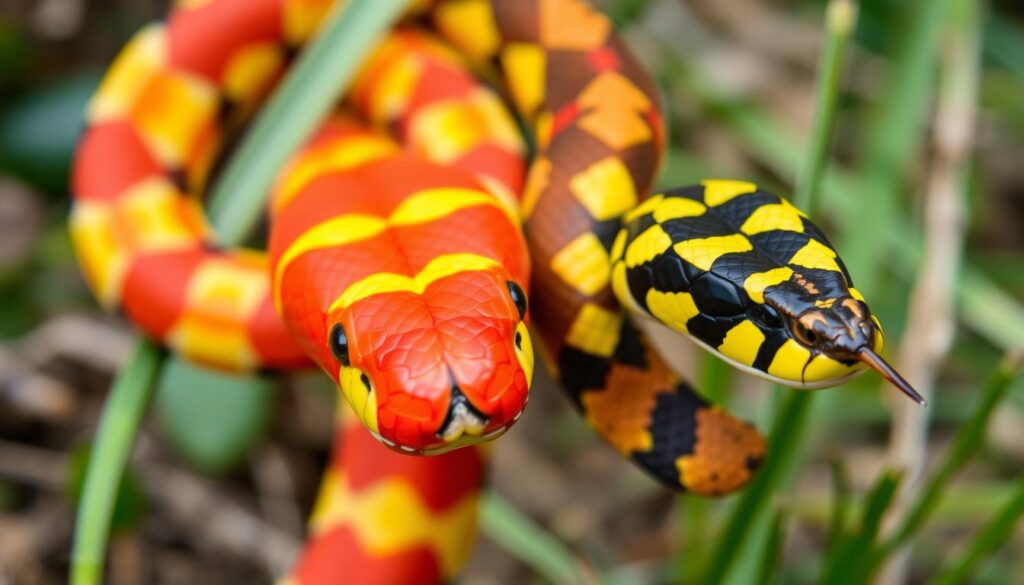
The color rule is helpful for identifying snakes, but it’s not the only clue. Always be careful and seek help if you see a snake you don’t know. This ensures your safety and correct identification.
You May Like:- Ukrainian Levkoy vs Sphynx: Hairless Cat Comparison
Venomous vs Non-Venomous Characteristics
Coral snakes have a very potent snake venom that can harm the nervous system. This can lead to paralysis and breathing problems. Their venom is among the most toxic in North America. Coral snake bites are rare but very dangerous and need quick medical help.
King snakes, on the other hand, are non-venomous. They use their strength to wrap around their prey. They are immune to the venom of other snakes, including coral snakes. A king snake bite might hurt, but it’s not serious and usually just needs basic care.
The snake bite symptoms from king snakes are usually mild. They don’t pose a big risk to people’s health.
| Characteristic | Coral Snake | King Snake |
|---|---|---|
| Venom Type | Neurotoxic | Non-venomous |
| Venom Potency | Highly Potent | No Venom |
| Bite Severity | Potentially Life-Threatening | Mild, Rarely Requires Treatment |
| Prey Subduing Method | Venom | Constriction |
| Venom Immunity | No | Yes, to Other Snake Venoms |
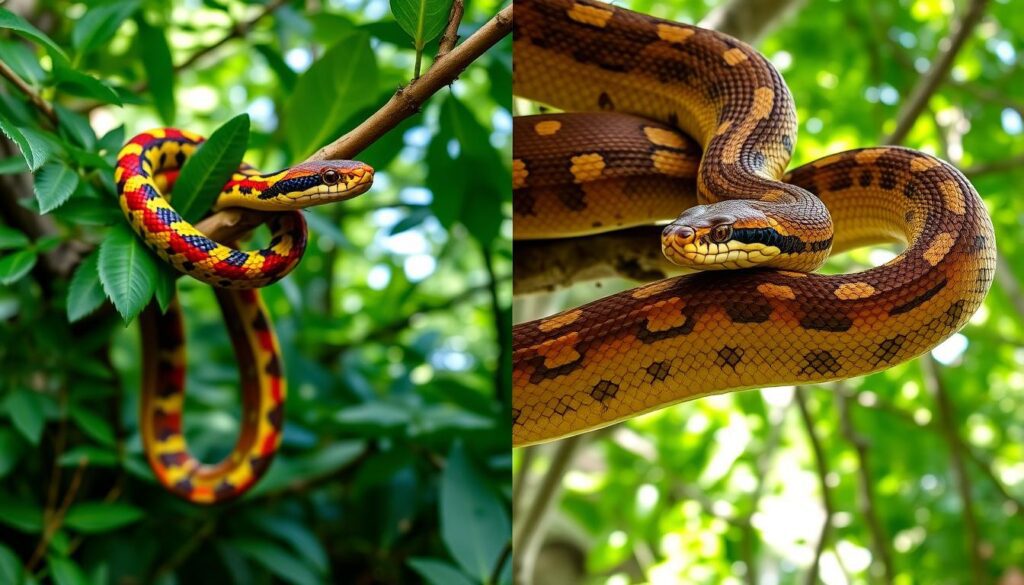
Geographic Distribution and Habitats
The coral snake and king snake species in the United States have different places they like to live. Coral snakes mostly live in the southeastern region, like Florida, Georgia, and parts of Texas. They like forests, sandy areas, and wetlands. On the other hand, king snakes live in many places across North America. They can be found in forests and deserts.
Southeastern United States Population
The eastern coral snake is often seen in southern Florida. Different king snake species live all over the country. They both like the same areas in the southeastern United States.
Desert and Forest Adaptations
Coral snakes like dry places, while king snakes can live in many different places. They can be found in both dry desert areas and green forested places. This makes them very good at living in many different places.
Overlap Zones
The southeastern United States is a great example of where coral snakes and king snakes live together. Here, their homes overlap, leading to chances for them to meet and compete. Knowing how these overlap zones work is key for protecting these snakes and managing their homes.
Hunting and Feeding Behaviors
The coral snake and the king snake have different ways of hunting and eating. Coral snakes mainly eat smaller snakes, lizards, and frogs. They use their venom to quickly stop their prey before they eat it.
King snakes, on the other hand, are constrictors. They wrap around their prey to suffocate it before eating. Their diet includes small mammals, birds, lizards, and other snakes, even venomous ones. King snakes are famous for eating snakes bigger than themselves.
Both snakes are important in controlling prey populations in their ecosystems. The coral snake uses venom, while the king snake uses physical strength. Knowing how they hunt and eat helps us understand their unique adaptations and roles in nature.
Scarlet kingsnakes, a non-venomous species, eat small lizards, rodents, and other small snakes. They hunt during the day and night, mostly at dawn or dusk. Adult scarlet kingsnakes are 14 to 20 inches long. They can be confused with venomous coral snakes or non-venomous scarlet snakes because of their bright colors.
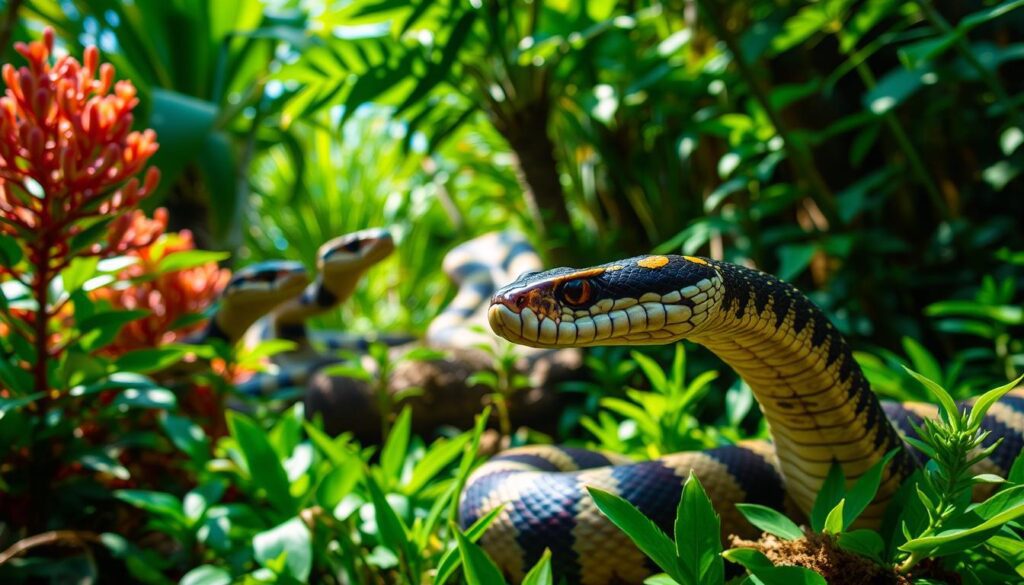
The Arizona Mountain Kingsnake is usually 3 to 4 feet long. It’s known for eating venomous snakes like rattlesnakes. This shows its important role as a predator in its ecosystem.
Physical Features and Size Comparison
Understanding the physical features and size differences between coral snakes and king snakes is key. Both have unique traits that help in identifying them. This is important for snake lovers and outdoor enthusiasts.
Head Shape Differences
Coral snakes have small, rounded heads that match their bodies well. King snakes have more angular heads. This small difference can help tell them apart.
Body Length and Build
Coral snakes are usually smaller, about 18 to 20 inches long. King snakes can grow up to 72 inches long. King snakes also look more muscular than coral snakes.
Scale Patterns
Both have shiny scales, but their patterns are different. Coral snakes have brightly colored bands around their bodies. King snakes have varied patterns. Coral snakes also have small, black eyes, while king snakes have larger eyes with round pupils.
These differences help in identifying them. But, remember, don’t rely only on these. Location and behavior also play a part in telling them apart.
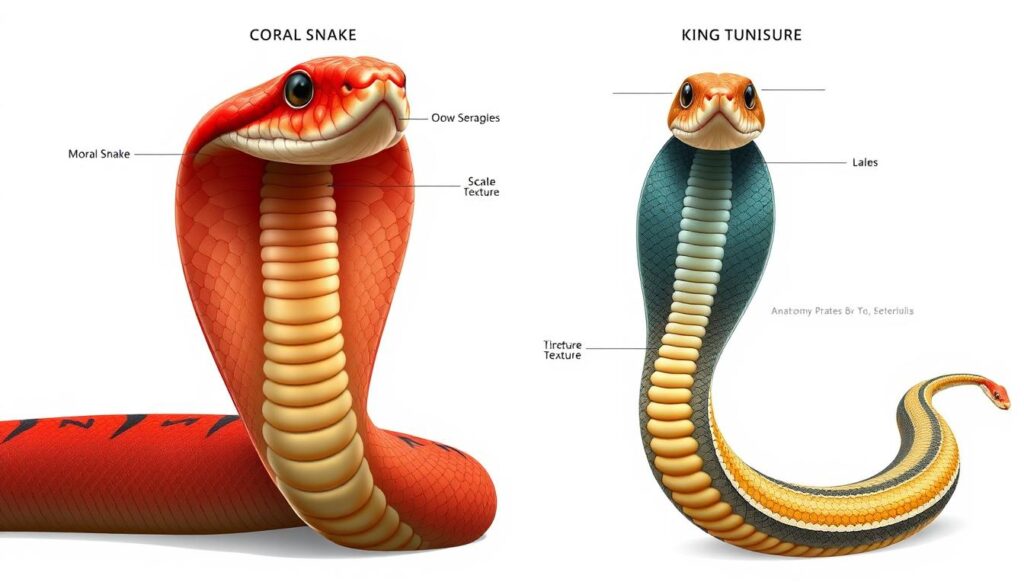
Defensive Mechanisms and Behavior
Snakes like coral and king snakes have different ways to defend themselves. Coral snakes are shy and hide when they see people. Their bright colors warn predators to stay away. When scared, they flatten their bodies, hiss, or hide their heads and tails.
King snakes, being non-venomous, use mimicry and physical defense to protect themselves. They might vibrate their tails, release a musky smell, or coil up when threatened. Both snakes usually avoid humans because they are not aggressive towards people.
- Coral snakes use escape and threat displays such as rearing back, opening their mouths, or coiling defensively when feeling threatened.
- Snakes like the California Kingsnake and Western Black-headed Snake exhibit open-mouthed threat displays to deter predators.
- Snakes often use cryptic coloration and patterns for camouflage, such as the Southwestern Speckled Rattlesnake blending in with rocks.
- Defensive coiling is a common behavior, with species like the California Kingsnake and Common Sharp-tailed Snake exhibiting this tactic.
- Rattlesnakes and Gophersnakes may shake their tails as a warning when feeling distressed or threatened.
Even though coral snakes are very venomous, they are rarely seen because they are so secretive. King snakes, on the other hand, are generally calmer and are sometimes kept as pets.
| Defensive Mechanism | Coral Snake | King Snake |
|---|---|---|
| Camouflage | Bright warning colors | Cryptic patterns for blending in |
| Threat Display | Flattening body, hissing, hiding head | Vibrating tail, releasing musky odor, coiling |
| Venom Potency | Highly venomous, neurotoxic | Non-venomous, relies on mimicry |
| Encounter Frequency | Reclusive, rarely encountered | More commonly encountered, sometimes kept as pets |
Snake Safety and Identification Tips
Meeting a snake can be scary, but knowing what to do can help. Keep a safe distance and let the snake go away. Avoid handling or provoking snakes, even if they appear non-venomous.
What to Do During an Encounter
- Stay calm and slowly back away, giving the snake room to leave.
- Don’t try to catch or kill the snake, as this raises the risk of a snake bite.
- If you think the snake is a coral snake, get medical help right away, as their venom is deadly.
- For king snake sightings, just leave the area.
Prevention Methods
To lower the risk of snake encounters, keep your yard clean and seal up buildings. Wear protective clothes in areas where snakes are common. Learning about local snakes and their habits is key to living safely with them.
Emergency Response Guidelines
If you think you’ve been bitten by a snake, have emergency numbers ready. Don’t try to catch or kill the snake to figure out what it is. Stay calm, keep the bitten limb steady, and get medical help fast.
By following these snake safety tips and knowing how to spot different snakes, you can enjoy the outdoors safely. This way, you can avoid snake bite prevention issues.
Conservation Status and Threats
Neither coral snakes nor king snakes are endangered now. But, they face dangers like habitat loss, being hit by cars, and being killed by people. Some king snake types are at risk in certain places. Coral snakes, being shy and needing specific homes, might be more at risk from changes in the environment.
Efforts to save snakes include protecting their homes, teaching people not to kill them, and studying their numbers. Climate change and urban growth are big challenges for snakes. This shows we need to keep working on snake conservation and protecting their homes.
The Eastern Coral Snake, known as Micrurus fulvius, is not common in North Carolina. It’s listed as Endangered there. Coral snakes are very rare, and there have been no recorded bites on humans in North Carolina. This shows how rare and hidden they are.

In Florida, there are 44 native snake species, with 6 being venomous, like the eastern coral snake. Snakes help control rodent numbers, which can harm crops and spread diseases. Some snakes even eat ticks, showing their value in nature.
The Eastern Indigo Snake is at risk in Florida and is protected. It’s important to remember that snakes only bite when they feel threatened. They usually avoid people and pets.
| Statistic | Value |
|---|---|
| Size | 18-30 inches |
| Population | 100,000 individuals |
| Lifespan | 7 years |
| Number of eggs laid by females | Between 3 and 12 |
| Conservation Status | Least Concern |
| Estimated adult population in 2004 | 100,000 snakes |
| Threats | Motor vehicles, habitat loss and degradation from residential and commercial development, invasive species impact (e.g., decline in Alabama due to fire ants predation) |
Seeing snakes near buildings might mean there are rodents around. Keeping areas clean can help keep snakes away too. Coral snakes hunt during cooler times and have a special way of reproducing.
Impact on Human Communities
Coral snakes and king snakes have different effects on people. Coral snake bites are rare, happening about 20 times a year in the U.S. They need quick antivenom treatment. King snakes, on the other hand, are harmless to humans.
Both snakes help control pests in farms by eating rodents and other snakes. But, people often kill them out of fear. This harms the local environment. Programs try to teach people about these snakes’ importance and how to live with them.
In some places, king snakes are seen as good because they keep venomous snakes like rattlesnakes in check. This helps keep communities safe from dangerous snakes.
Coral snake bites, though rare, are medical emergencies requiring antivenom treatment, while king snakes, being non-venomous, pose no significant health risk to humans.
It’s key to find a balance between dealing with snake-human interactions, managing wildlife, and teaching about snake bite statistics. This ensures safety for both humans and animals.
Conclusion
It’s important to know the difference between coral snakes and king snakes. This knowledge helps keep people safe and supports wildlife conservation. These snakes look similar, but they have different venom, behavior, and roles in their ecosystems.
Teaching people about snake identification and safety is key. It helps us live in harmony with these reptiles. As we change our environment, it’s vital to protect these creatures. This way, we keep our ecosystems healthy.
This article has compared coral snakes and king snakes to help you stay safe. Knowing about these snakes helps us appreciate the variety of life around us. It also helps us live in peace with snakes.
FAQ
What are the key differences between coral snakes and king snakes?
Coral snakes are very venomous with a strong neurotoxin. King snakes are not venomous. Coral snakes have red and yellow bands that touch. King snakes have red and black bands that don’t touch.
How do coral snakes and king snakes play different roles in their ecosystems?
Coral snakes keep small reptile populations in check. King snakes eat other snakes, including venomous ones. They can even eat snakes bigger than themselves.
What is the significance of snake mimicry in the relationship between coral snakes and king snakes?
King snakes look like venomous coral snakes, a trick called Batesian mimicry. This helps king snakes avoid predators.
How can you reliably distinguish between coral snakes and king snakes?
The rhyme “Red touch yellow, kill a fellow; red touch black, venom lack” is helpful. But it’s not always right. Always get help from a pro if you’re not sure.
What are the key differences in the venom and hunting methods of coral snakes and king snakes?
Coral snakes have strong venom that can paralyze. King snakes are non-venomous and squeeze their prey to death.
Where are coral snakes and king snakes typically found in the United States?
Coral snakes live mainly in the southeastern U.S. King snakes are found all over North America, in many different places.
How do the physical characteristics of coral snakes and king snakes differ?
Coral snakes have small heads that blend with their bodies. King snakes have more distinct heads. Coral snakes are smaller, up to 20 inches long. King snakes can be up to 72 inches long.
How do coral snakes and king snakes respond to threats?
Coral snakes are shy and hide a lot. King snakes are more friendly and can be pets. Both may flatten their bodies, hiss, or coil up when threatened.
What are the conservation concerns for coral snakes and king snakes?
Both face threats like habitat loss and being killed by humans. Some king snake subspecies are at risk. Coral snakes are harder to find because they live in specific places.
How do coral snakes and king snakes impact human communities?
Coral snake bites are serious and need antivenom. King snakes are safe for humans. Both help control pests by eating rodents and other snakes.


